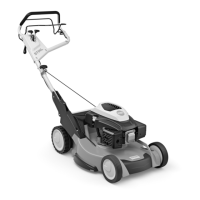47
DEFRNLITESPTNOSVFIDAPLSLSKTR EN
0478 111 9953 B - EN
Petrol must only be stored in appropriate,
tested containers (canisters). Always
screw on the fuel tank and canister caps
properly and tightly. Defective caps must
be replaced for safety reasons.
Never use beverage bottles or similar for
disposal or storage of fuels and lubricants.
Persons, particularly children, could be
tempted to drink out of them.
Keep petrol away from sparks,
naked flames, pilot lights, heat
sources, and other ignition
sources. Do not smoke!
Refill the tank out-of-doors and do not
smoke during refilling.
Before refilling the tank, stop the engine
and allow it to cool.
Refilling with petrol must be performed
before the engine is started. When the
engine is running or is hot, the tank cap
must not be removed and the tank must
not be refilled with petrol.
Do not overfill the fuel tank!
To give the fuel room to expand,
never fill the fuel tank past the
lower edge of the filler neck.
Observe the additional
instructions in the engine
instruction manual.
If petrol is spilled, the engine
must only be started after the petrol-
contaminated area has been cleaned. All
attempts at starting must be avoided until
the petrol fumes have dispersed (wipe
dry).
Any spilt fuel must be wiped up
immediately.
Clothing must be changed if it comes into
contact with petrol.
Never store the machine with petrol in the
tank inside a building. The resulting petrol
fumes could come into contact with naked
flames or sparks and could be ignited.
If it is necessary to drain the tank, this must
be done out of doors.
5.3 Battery and charger
Read the engine instruction manual and
keep it in a safe place. This instruction
manual describes how to safely use the
battery and charger.
Only use genuine batteries and genuine
chargers.
Protect the battery and charger against
rain and moisture and do not drop.
Do not use a damaged or deformed
battery or a damaged charger. In particular
check the power cable of the charger.
Never use a charger with a damaged
power cable.
Never dismantle or attempt to repair a
battery or charger. A defective battery or
charger must be replaced.
Only connect the charger to a power
supply that is protected by means of a
residual current-operated protective
device with a maximum release current of
30 mA. Your electrician can provide further
information.
Keep the unused battery away from metal
objects (e.g. nails, coins, jewellery). Never
short circuit battery connections, do not
use metal containers to transport batteries.
Fluid may escape from the battery due to
improper use – avoid contact! In the case
of inadvertent contact, rinse with water.
Seek medical attention if the fluid contacts
the eyes. Escaping battery fluid can cause
skin irritation and burns.
For further safety instructions, see
http://www.stihl.com/safety-data-sheets
5.4 Clothing and equipment
Always wear sturdy footwear
with high-grip soles when
working. Never work barefoot
or, for example, in sandals.
Also always wear sturdy gloves
and tie up and secure long hair
(headscarf, cap, etc.) when
performing maintenance and
cleaning work or when transporting the
machine.
Wear suitable safety glasses
when sharpening the mowing
blade.
Always wear long trousers and
tight-fitting clothing when operating the
machine.
Never wear loose clothes which may
become caught on moving parts (control
levers) – do not wear jewellery, ties or
scarves.
Noise is produced when
working. Noise can damage the
hearing.
Wear hearing protection.
5.5 Transporting the machine
Always wear protective gloves ( 5.4) in
order to prevent injuries due to sharp-
edged and hot components.

